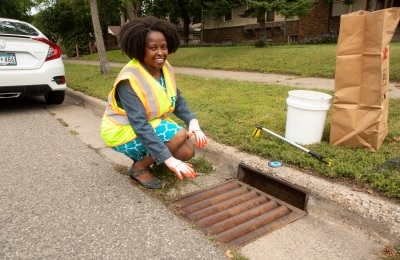Keeping rainwater in your yard
Keeping rainwater on your yard is a good way to prevent localized flooding and protect water quality. As we head into the rainiest time of the year, it’s a good time to make a plan for how you will capture and reuse rainwater at home.
Our climate is getting wetter
Climate change means more rain in our region. The 2010s was the wettest decade on record in Minnesota, and projections indicate these trends will continue.

Rainwater running off our roofs, lawns, sidewalks, and driveways flow into storm sewers on our streets. Clogged or overrun storm sewers contribute to street flooding.
Rainwater also picks up pollutants like leaves, grass clippings, sediment, oil, and lawn chemicals and carries them into nearby storm drains.
Storm sewers flow directly into nearby lakes, rivers, and streams, where the pollutants from our homes and yards contribute to algae blooms, harm fish and wildlife, and impact our drinking water supply.
Watch where the rain flows
Next time it rains, pay attention to where the water flows around your house. This will help you identify any drainage issues and low spots where you could capture water.
Design a rain garden

A rain garden is bowl-shaped garden that is designed to collect and infiltrate stormwater runoff from hard surfaces such as roads, driveways, roofs, and sidewalks. The flowering native plants in rain gardens also provide food and habitat for pollinators like butterflies and bees.
Rain gardens should be strategically placed to collect water flowing off your roof or driveway. They should be designed to infiltrate water within a day or two, and they should be planted with plants that can withstand both dry and wet conditions.
Start designing your rain garden today using resources from Blue Thumb or Metro Blooms. Or register for a Metro Blooms Resilient Yard workshop. You’ll learn about sustainable yard care practices including rain gardens and get personalized design assistance.
Install a rain barrel

Rain barrels capture rain from roofs and downspouts and store it for you to use to water your yard or garden at a later time. This is a great way to reduce runoff and provide easy, free access to water for your landscape.
You can purchase a rain barrel or make your own. You can purchase rain barrels at garden and hardware stores. Search online for instructions for making your own — Better Homes and Gardens and Instructables are good places to start.
You may have to shorten your downspouts to get your rain barrels to fit, and you may want to consider elevating your rain barrel so gravity can help when you’re using the water.
If you have a big enough surface that your rain barrels are collecting water from (like the roof of your house), you may want to install two rain barrels.
Learn more tips for installing rain barrels at Clean Water Minnesota.
Redirect your downspouts

Having downspouts flow into vegetated areas of your yard rather than onto the driveway or into the street is one of the simplest ways to reduce runoff. The Mississippi Watershed Management Organization provides tips for where to direct your downspouts and the materials you will need to make it happen.

Adopt a drain on your street
Do something to stop the pollution on your street and in your local lakes and rivers — adopt a drain! It takes 15 minutes, twice a month, to sweep up, rake up, pick up the leaves and litter before it goes down the drain.


